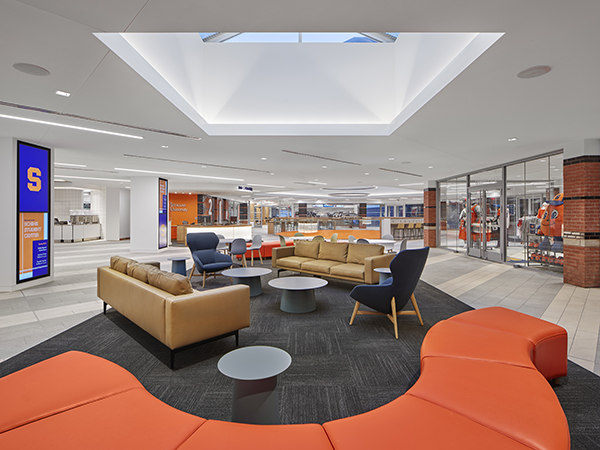
The Schine Student Center has been a focal point for student activities on Syracuse University’s campus since its construction in 1985. Nearly 35 years after the student center was completed, the university reevaluated the building’s design.
Featuring several Syracuse alumni, Mackey Mitchel Architects and Ashley McGraw Architects partnered to transform the Schine Student Center with current design best practices and Syracuse student feedback. Gathering student comments from online surveys, informal suggestions and other forms of input, the design firms planned the 108,000 square foot renovation to prioritize visual and physical connection, accessible circulation and a comfortable and memorable environment.
The Schine Student Center has a central atrium with four adjoining quadrants. The connections between these spaces are important to promoting openness throughout built environment. However, fire- and life-safety codes required the use of fire-rated materials at these points. This posed two challenges to the design teams: how to achieve code-compliance without sacrificing visual connection and how to create a cohesive design with fire-rated materials.
Transparent fire-rated glazing minimizes design compromise
“Visual connection was the primary driver for the design of the renovation,” says Benjamin Darby, architect at Ashley McGraw Architects.
This was achieved by replacing isolated zones within the central atrium with inviting vistas and by preserving open sightlines between the quadrants and atrium through the use of transparent, fire-rated glazing assemblies and adjacent non-rated assemblies.
The use of full-lite fire-rated glass doors within narrow-profile, fire-rated glass storefronts maintain the visual connection central to the renovation. They also protect egress stairwells and compartmentalize the building. Previously, this level of protection may have only been achievable with opaque materials or with limited amounts of glazing. Now, fire-rated assemblies allow architects to meet requisite codes without hindering the desire for visual connection.
Darby continues, “When a student walks into the building, they are given sightlines into each of the quadrants, as well as clear wayfinding to help navigate through the expansive building.” This helps create a welcoming atmosphere that encourages students to connect with each other and the programs housed in the student center.
Butt-glazed assemblies lets students see orange
While the storefront assemblies help maintain visual connection at crucial points throughout the building’s quadrants, fire-rated glazing also contributes to a sense of openness within the central atrium itself. The fire-rated butt-glazed assemblies that surround the campus store provide a prime example. These transparent, floor-to-ceiling glass wall panels stretch between structural supports and provide a 60 minute fire rating. Rather than opaque vertical mullions, the glass wall panels come together at a five millimeter butt-joint, which maximizes the amount of glazing within the perimeter frames.
Because these assemblies allow uninterrupted views into and through the campus store, they facilitate easy wayfinding for both new students looking to buy textbooks and visitors wanting to snag Syracuse clothing and gifts. Though the glass itself is impressive, the minimal aluminum perimeter frames and butt-glazed joints also create a coherent design throughout the student center.
Narrow-profile frames support a uniform glazing design
Not all the glazing within the Schine Student Center needed to be fire rated. Throughout the building, rated and non-rated assemblies were specified near each other. To preserve a seamless look, the designers chose fire-rated frames and glass that provide a close visual match to non-rated systems.
“The success of these glazing applications can be found in their non-unique appearance. Our design team valued Technical Glass Products’ fire-rated systems’ ability to frame views between spaces, while being non-intrusive and uniform with other interior glazing used in the project,” Darby says.
Since the fire-rated glazing systems complement adjacent non-rated assemblies, they allowed the design firms more freedom to create impressive and visually connected spaces, whether or not a fire rating was required in a specific application.
Project awards and recognitions
The Schine Student Center has won architectural excellence awards from Central New York’s chapter of the American Institute of Architects (AIA), the Association of College Unions International (ACUI) and the Illumination Engineering Society (IES). These awards cite the project’s commitment to the principles of Universal Design, Student-Centered Design and Design for Diversity and Inclusion.
The jury’s comments for the AIA award state the renovation created a “dramatic improvement in terms of visibility, engagement and inviting spaces of this essential campus building.” While several systems come together for this improvement, fire-rated glazing plays a crucial role by preserving visibility where previously opaque materials might have been a code-driven necessity.

